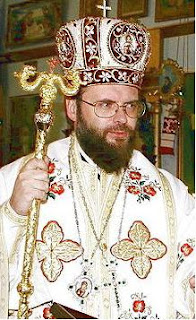+NICOLAE
Archbishop of the Romanian Orthodox Archdiocese in the Americas
The spiritual journey through Lent is marked by the Sundays of Lent, each one having a precise significance. First we cele-brate the victory of the Orthodox faith over the heresies of the year 843, victory ex-pressed by the re-establishment of the ven-eration of the icons. Then we honor St. Gregory Palamas, the archbishop of Thessa-lonica, who has defended the true teaching regarding the uncontained nature of God and His uncreated energies which pour out upon the world. We may consider this first part of Lent as one involving dogmatic con-notations, as a sign of reflection upon the teaching of the Church. On the third Sunday of Lent, mid-Lent, the Church has estab-lished the veneration of the holy and life-giving Cross of Christ as strength and en-couragement for spiritual drive in the ful-fillment of the Lent.
On the forth Sunday of the Paschal Lent we honor the author of a well-known written work for Orthodox spiri-tuality “The Ladder of Divine Ascent”, namely St. John of Sinai or of the Lad-der, of known by the Latin translation: Climacus. St. John lived between the years 579 and 649, spending his monas-tic life firstly under obedience to his confessor, then for 40 years, in a se-cluded life of peace and prayer. Only after this long trial did he accept to become the abbot of the Sinai Monas-tery, during which time he wrote the “Ladder”, as answer to the request of the abbot John of the neighboring Raith Monastery. He wrote it in order to give the monks a written rule by which to live in ascent toward heaven as on a ladder, as the one seen by the Patriarch Jacob.This spiritual treatise, recom-mended as the first reading during the Holy Lent, could not be written but by someone who had already experienced what he wrote. Thus it is considered that St. John himself accomplishes the course of this ladder, being himself the living model of this spiritual knowledge. In one of the hymns of the canon for the feast day of St. John we read: “Strengthening the virtues as steps, truly you have ascended toward the heavens shining through the orthodox faith at the immeasurable depth of watching those above, conquering all the attacks of the demons and you, O John, you ladder of virtues, protect the people; and now you pray that your servants may be saved”. St. John Cli-macus represents the icon of abstinence and asceticism, thus his commemoration on this occasion is an opportunity to search ourselves and to remind our-selves of the role of the Holy Lent in our lives. The hymnology of the forth Sun-day of Lent speak of his ascetical strug-gles through which he destroyed the passions and acquired the cleansing of passionlessness. By the power of the Holy Spirit he became master of his own body, reaching, on the wings of prayer, the spiritual light of contemplation, thus later enlightening the world and nourishing his disciples with the fruits of abstinence. St. John Climacus appears to us as a righteous model of monasti-cism and spiritual knowledge into which we are initiated during the Great Lent. May the evoking of his virtues be an occasion to feast and joy for all who long to become monastics during Lent, meaning united with God and pacified in our souls.

